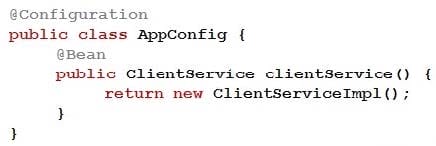Exam Details
Exam Code
:2V0-72.22Exam Name
:Professional Develop VMware SpringCertification
:VMware CertificationsVendor
:VMwareTotal Questions
:60 Q&AsLast Updated
:Mar 19, 2025
VMware VMware Certifications 2V0-72.22 Questions & Answers
-
Question 11:
Which two statements are correct regarding the Health Indicator status? (Choose two.)
A. The last status in a sorted list of HealthIndicators is used to derive the final system health.
B. The status with the least severity is used as the top-level status.
C. Custom status values can be created.
D. The built-in status values are DOWN, OUT_OF_SERVICE, UNKNOWN, and UP in decreasing order of severity.
E. The severity order cannot be changed due to security reasons.
-
Question 12:
Which statement about @TestPropertySource annotation is true? (Choose the best answer.)
A. Java system properties have higher precedence than the properties loaded from @TestPropertySource.
B. Properties defined @PropertySource are not loaded if @TestPropertySource is used.
C. @TestPropertySource annotation loads a properties file relative to the root of the project by default.
D. Inlined properties defined in @TestPropertySource can be used to override properties defined in property files.
-
Question 13:
Which two statements are correct regarding the Actuator info endpoint? (Choose two.)
A. It provides configuration options through which only an authenticated user can display application information.
B. It is not enabled by default.
C. It can be used to display arbitrary application information.
D. It can be used to change a property value on a running application.
E. Typically it is used to display build or source control information.
-
Question 14:
Refer to the exhibit.

Which statement is true? (Choose the best answer.)
A. CustomerRepository should be a class, not an interface.
B. JPA annotations are required on the Customer class to successfully use Spring Data JDBC.
C. An implementation of this repository can be automatically generated by Spring Data JPA.
D. A class that implements CustomerRepository must be implemented and declared as a Spring Bean.
-
Question 15:
Which statement describes the @AfterReturning advice type? (Choose the best answer.)
A. The advice is invoked only if the method returns successfully but not if it throws an exception.
B. The @AfterReturning advice allows behavior to be added after a method returns even if it throws an exception.
C. The advice has complete control over the method invocation; it could even prevent the method from being called at all.
D. Typically used to prevent any exception, thrown by the advised method, from propagating up the call-stack.
-
Question 16:
Refer to the exhibit.

How can a response status code be set for No Content (204)? (Choose the best answer.)
A. Annotate the update() handler method with @PutMapping("/store/orders/{id"}", HttpStatus.NO_CONTENT).
B. Annotate the update() handler method with @ResponseStatus(HttpStatus.NO_CONTENT).
C. Annotate the update() handler method with @ResponseEntity(204).
D. The update() handler method cannot return a void type, it must return a ResponseEntity type.
-
Question 17:
Which two statements are correct regarding Spring Boot auto-configuration? (Choose two.)
A. Auto-configuration uses @Conditional annotations to constrain when it should apply.
B. Auto-configuration could apply when a bean is missing but not when a bean is present.
C. Auto-configuration is applied by processing candidates listed in META-INF/spring.factories.
D. Auto-configuration could apply when a bean is present but not when a bean is missing.
E. Auto-configuration is applied before user-defined beans have been registered.
-
Question 18:
Which two statements are true regarding storing user details in Spring Security? (Choose two.)
A. With a custom UserDetailsService defined in the ApplicationContext, Spring Boot still creates the default user.
B. Passwords must be hashed and the default hashing algorithm is MD5.
C. User details can be stored in custom storage and retrieve them by implementing the UserDetailsService interface.
D. User details can be stored in a database, in LDAP, or in-memory.
E. The user details includes username and password but not authorities.
-
Question 19:
Which two statements are true regarding @DataJpaTest? (Choose two.)
A. TestEntityManager provides all methods that are provided by EntityManager and more.
B. If an embedded database is on the classpath, it will be used to configure a DataSource by default.
C. It can be used for testing both JPA components and NoSQL components.
D. It auto-configures a TestEntityManager bean.
E. It can be used for testing JdbcTemplate.
-
Question 20:
Refer to the exhibit.

What is the id/name of the declared bean in this Java configuration class? (Choose the best answer.)
A. clientServiceImpl (starting with lowercase "c")
B. clientServiceImpl (starting with uppercase "C")
C. clientService (starting with lowercase "c")
D. ClientService (starting with uppercase "C")
Related Exams:
1V0-21.20
Associate VMware Data Center Virtualization1V0-31.21
Associate VMware Cloud Management and Automation1V0-41.20
Associate VMware Network Virtualization1V0-61.21
Associate VMware Digital Workspace1V0-71.21
Associate VMware Application Modernization1V0-81.20
Associate VMware Security2V0-21.20
Professional VMware vSphere 7.x2V0-21.23
VMware vSphere 8.x Professional2V0-31.21
Professional VMware vRealize Automation 8.32V0-31.23
VMware Aria Automation 8.10 Professional
Tips on How to Prepare for the Exams
Nowadays, the certification exams become more and more important and required by more and more enterprises when applying for a job. But how to prepare for the exam effectively? How to prepare for the exam in a short time with less efforts? How to get a ideal result and how to find the most reliable resources? Here on Vcedump.com, you will find all the answers. Vcedump.com provide not only VMware exam questions, answers and explanations but also complete assistance on your exam preparation and certification application. If you are confused on your 2V0-72.22 exam preparations and VMware certification application, do not hesitate to visit our Vcedump.com to find your solutions here.